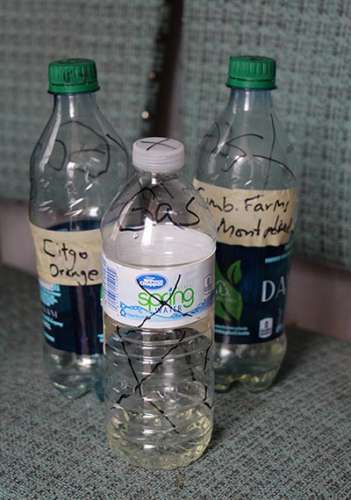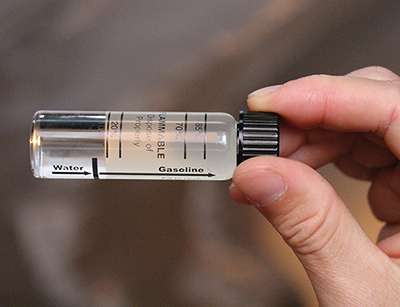The lab (okay, garage) here at Northern Woodlands was the scene last week of some high-tech testing. Using the latest in scientific hardware – a small glass vial purchased on Amazon for $12.54 – we conducted a series of experiments to test the ethanol content of different gasoline samples. The purpose wasn’t to produce a peer-reviewed paper, but simply to have a little fun and learn more about a topic we’re covering in the Winter issue of Northern Woodlands: the impact ethanol can have on power equipment such as chainsaws.
Ethanol is alcohol – the stuff you sip at cocktail parties or your favorite pub. It’s also a fuel, and a politically charged topic. Corn growers in Iowa tend to like its inclusion in gasoline. Small engine repair shops most certainly do not (though it brings in quite a bit of business). While most new equipment is designed to operate on the 10 percent ethanol/90 percent gasoline mixtures common at most gas pumps, manufacturers and technicians warn that even at that level ethanol can make engines run hotter and, if left to sit in equipment, ruin carburetors, fuel filters, and even dissolve the plastic fuel lines of older equipment. And there are reports that the actual ethanol content in gasoline can vary widely, sometimes rising much higher than the 10 percent level labeled on most gas pumps.
We wanted to see just how much ethanol was in our gasoline. I collected samples at random from six gas stations around central Vermont. The tricky part was trying to buy about 3 cents worth of gas, all it takes to run the test. At one station, at 6:15 on a dark, rainy morning, I explained to the woman at the pump next to mine what I was up to and asked if she wouldn’t mind adding just a splash of gas to my specimen container. She was pumping a small amount through my funnel into a soda bottle when her husband walked out of the station, looked sideways at the scene and just said, “I’m not even going to ask...” before getting in the car.
Back at the lab, we filled the vial – designed for just this purpose – with water up to the prescribed line, then topped it off with gasoline, put on the cap, shook the vile and waiting a minute or so. Within seconds, the water and gasoline began to separate as the water, which settled on the bottom, drew any ethanol out of the gasoline above. Scary to think this is what’s happening in the gas tank of your chainsaw/car/lawn mower. It’s also what can happen in the underground storage tanks at gas stations, leading some to speculate that it’s better to buy gas at stations that pump a lot of gas, which keeps things mixed up.
None of the samples we tested exceeded 10 percent ethanol, though interestingly, two samples that were advertised as E10 showed hardly a trace of it. Given the small sample size and the fact that the testing was conducted by two writers who last took science classes in the early 1990s, the results were, perhaps, a fluke. The reality is there is no certain way to know how much ethanol is in the gasoline you’re buying without testing each batch. (There are a few stations that advertise ethanol-free gas.)
Even looking beyond the potential mechanical problems that ethanol can create when blended in gasoline, it’s difficult to understand the rationale behind the regulations that require it. All joking aside about the scant controls we had in place during our testing, there’s even less scientific credibility behind the argument that putting ethanol in gasoline makes any sense at all. While ethanol theoretically replaces 10 percent of the petroleum product in gasoline with a renewable product, it also offers only 66 percent of the energy content of straight gas (while costing more to produce the same amount of energy). Stop blending ethanol into gasoline and the fuel economy of every gas-burning car and truck on the road would immediately increase by 3 to 4 percent (that’s according to fueleconomy.gov) and the cost of every mile you drive would drop even more. Then there are ancillary consequences. About 13.2 billion gallons of ethanol fuel were produced in 2013, requiring nearly 5 billion bushels of corn, or about 40 percent of the total grow in the U.S. (This piece in Forbes provides an even more detailed look at the issue.) The bottom line is that the energy investment in farm equipment, fertilizers, pesticides, trucking, processing, trucking, refining, trucking, is huge, and all for a product that reduces fuel efficiency, damages engines, and increases food prices by reducing the supply of corn on the food market. The lesson, I think, is that a good team of lobbyists trumps a good team of scientists. (Especially amateur scientists working in a garage.)
If you’re not in a position to immediately alter farm and energy policy in the U.S., the best you can do is protect yourself. If you’re done using your chainsaw or mower for the year, run it dry, advise the experts. And when you start it up next spring, buy fresh gas - ethanol-free if you can find a local station selling it. Alcohol is a lot better in a glass than in a red can.




Discussion *